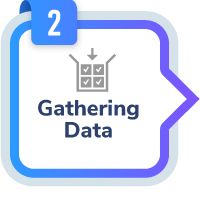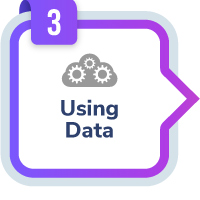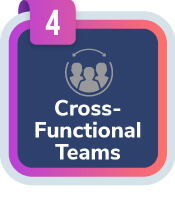Q&A: Building Cross-Functional Teams
As the threat landscape has changed, security leaders have had to adapt. It is infinitely important that the leaders responsible for safety and security on university and healthcare campuses comprehend and strike a balance between needs versus wants as they build their programs to respond to changes. In this four-part Q&A, learn how four security leaders in healthcare and education tailor security programs and expectations using data, outreach, and partnerships.
Now that we have a better understanding of the data and its application, the final step is to put it into action. Some organizations and campuses suffer from siloed thinking and operations. Building cross-functional teams is an excellent way to break down walls and get important work accomplished. In this section, Frank Spano, John Dailey, Bonnie Michelman, and Lisa Terry discuss the value of cross-functional teams as part of an overall strategy, potential internal and external partnerships, and the importance of coordinating with peers at other organizations and campuses.
Why develop these teams in the first place?
Frank Spano: Campus communities are often plagued by a silo mentality wherein individual departments, schools, programs, or even individuals share data within tightly controlled vertical channels or silos rather than across the wider horizontal community—often at the detriment of constituents such as students who tend to exist outside the more formalized organizational structures.
John Dailey: Having the input and buy-in from multiple departments and multiple levels is critical to sustained success. Clinical, legal, compliance, administration, safety, and security all have a role. Teams are important—campus security and law enforcement are evolving from looking at things through a somewhat closed “this or that” perspective to incorporating more diverse and often differing perspectives unique to the campus community in order to create truly meaningful solutions or public safety.
Bonnie Michelman: It takes a true village to mitigate risk and diminish violence and other issues in the healthcare arena.
Healthcare vulnerabilities are diverse, and there are many often changing quickly. Having others from many departments can expand your ability to have trained and aware people who assist with the protection and risk management efforts.
It takes a true village to mitigate risk and diminish violence and other issues in the healthcare arena.
Security cannot be effective without mutual trust and understanding with all constituents, without good team building and bonding within themselves, and without understanding the mission and goals for the department. Everyone working in a healthcare facility needs to have an understanding of security, its importance, and how to use the services of the security department. People need to clearly know the breadth, depth, and expertise of the security team and how they can help with protection of the organization.
Generally, hospital employees and certainly security staff need to be empowered to make a difference, to diminish risk and to share concerns. If the security team is not included in important strategic discussions, it cannot maximize its effectiveness. It needs to be a full part of the healthcare team and feel that involvement and respect while also reciprocating it.
Lisa Terry: The 2017 McKinsey & Company comprehensive study of more than 70,000 employees from more than 200 companies did a great job in answering the question of why we should build cross-functional teams. The top-performing companies in the group they surveyed had the highest ratings in these measures:
- A diverse workforce promotes creativity;
- Challenging opinions on operational requirements defies the status quo because constantly defying the status quo is how organizations evolve; and
- A diverse mix of voices leads to more robust discussions and better outcomes.
Please provide examples of potential partnerships (internal and external). What are the synergies among these various stakeholders?
Spano: One of the critical elements of truly effective cross-functional teams is external involvement from trusted advisors, professional organizations, and related service providers. This ensures the most equitable and targeted facilitation of efforts, and it maximizes the opportunity for external benchmarking throughout the data collection, analysis, and implementation phases of effort. We find that our role in facilitating cross-functional groups provides additional opportunities to break down institutional silos, leverage best practices, and encourage an open and accountable data-driven organization.
Dailey: Of course, a large part of campus safety and security data revolves around the Clery Act. To ensure we have the most comprehensive data set to meet the regulatory requirements, we established a Clery compliance committee. This is an institution-wide organization, chaired by our vice president for administration, and it brings together representatives from all key components, athletics, general counsel, student life, human resources, Title IX, diversity and inclusion, and the like to report and collect data in one central function. This helps keep everyone on the same page and works to break down institutional silos.
The keys to establishing genuinely cross-functional teams capable of horizontal operation across a series of vertical institutional silos are twofold. First, it is critical to have the appropriate level of senior leadership emphasis and support. For example, our Clery committee shows institutional commitment and encourages involvement.
Second is relationships. Sure, there are regulatory compliance requirements that bring us together, but it’s about building and developing relationships and people being able to work together. As campus security and law enforcement professionals, we work every day with different institutional organizations with different priorities and responsibilities, and continuously work to build trust in their minds that we’re going to do the right thing when it comes to the information we receive.
Terry: There are numerous partnerships among various stakeholders. One example that stands out in the healthcare arena is the synergy derived between a safe and secure clinical environment and that of a productive workforce and gratified patient population. To establish this synergy, several internal and external partnerships must exist. These partnerships include security, patient safety, nursing, compliance, risk management, human resources, as well as external regulatory agencies.
Should we reach out to peers at other organizations or campuses?
Spano: There is tremendous value in benchmarking against other campuses. While each campus community is unique, there are far more similarities to be found across various campuses than there are differences.
Dailey: Yes. Our job is to serve our community—not to do things to the community. Where there may have been more trust that we’re doing it as they like, there’s much more interest today in how we do that. The best way to do that, and how the campus community interprets what we provide, are purpose-built feedback groups and programs.
Hearing other professionals’ issues, mistakes, successes, and best practices while sharing yours helps everyone to improve their ability to be successful.
Michelman: Absolutely. Hearing other professionals’ issues, mistakes, successes, and best practices while sharing yours helps everyone to improve their ability to be successful. This is critical to having an enlightened and successful security program.
We learn and grow together in this complicated arena and sharing your successes, mistakes, not having to always reinvent the wheel and simply having people you can collaborate or share with is invaluable. Community takes on a larger meaning as we all try to navigate changing risks, foreseeable and unforeseeable events, and the emotional and sometimes dangerous milieu of a healthcare facility.
Terry: With appropriate approval, do not hesitate to reach out to colleagues with whom you have built a relationship of trust and who may have previously led a change in his or her organization. Be willing to for ask assistance. You may be pleasantly surprised at what you discover.



